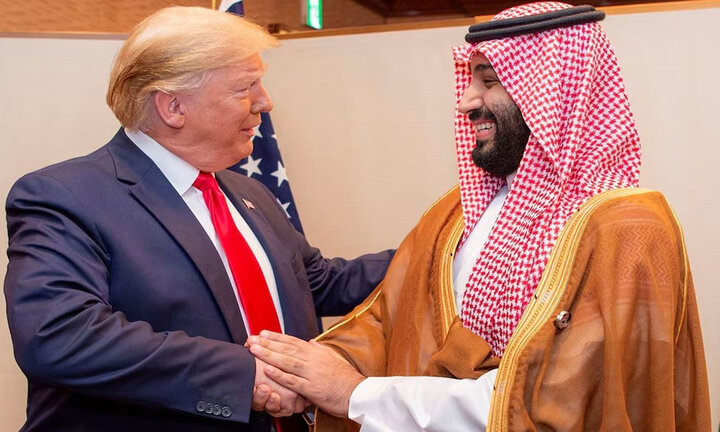Security and Normalization in Washington: Resetting Saudi Arabia’s Role in the New Middle East Order

webangah News Agency, International Desk: The visit of Saudi Crown Prince Mohammed bin Salman to Washington on November 18, 2025, marks a turning point in Riyadh-Washington relations and one of the most important geopolitical developments in the Middle East since donald Trump’s return to the White House. This trip comes amid multiple regional crises, including Iran’s nuclear tensions, the Gaza conflict, and rising competition among emerging powers. After feeling relatively isolated during biden’s presidency,Riyadh now seizes an opportunity under Trump’s deal-driven approach to secure a comprehensive package that cements its status as America’s main strategic partner in the Gulf. From Tehran’s perspective, this visit is not merely diplomatic but represents an organized effort to shift the balance of power against the resistance axis and contain the islamic Republic’s influence across the region. Both declared and undisclosed objectives-from nuclear plans to advanced weaponry and cutting-edge technologies-are at stake and could reshape Middle Eastern security dynamics for decades.
Saudi Arabia Seeks to Break Nuclear Taboo in the Middle East
A core secret aim of Mohammed bin Salman during this trip is securing U.S. approval for full nuclear fuel-cycle capabilities on Saudi soil-especially uranium enrichment. for years Riyadh has invoked provisions from its Section 123 civil nuclear agreement with America alongside a principle akin to “if Iran enriches uranium, so must we” as justification for its demands. The Trump administration-having withdrawn from the JCPOA during its first term and adopting an increasingly hardline anti-Iran stance-is expected to agree conditionally on limited enrichment levels (below 5 percent) in exchange for tens of billions of dollars invested by Saudi arabia into American infrastructure projects and treasury securities purchases. This concession would erode Iran’s relative monopoly over enrichment technology while bringing Riyadh closer to achieving near-nuclear capability within a short timeframe. Tehran views this as blatant evidence of Washington’s double standards-declaring peaceful Iranian programs threats while granting privileged exceptions for its close ally-and warns such moves will ignite a perilous regional nuclear arms competition.
Green Light Expected for F-35 Fighter Jet Sale
The sale of fifth-generation F-35 jet fighters stalled under Biden due primarily to human rights concerns and worries about upsetting Israel’s qualitative military edge now appears poised for revival under Trump’s return. He has openly stated that he fully supports selling these jets given what he describes as iran-related threats facing Saudi Arabia. As 2017 Riyadh has lobbied hard for at least 45 F-35s with readiness to pay over $40 billion. Calling arms deals “American job creators,” Trump will likely bypass congressional hurdles through confidential assurances provided directly to Israel so long as their strategic interests are preserved before clinching this deal fully.Introducing F-35s into Saudi air forces will firmly guarantee Riyadh air superiority over other regional militaries while dramatically boosting precise surveillance and strike capacities against critical iranian targets deep inside their territory.
For Iranian national security officials, this arms sale signals an unprecedented shift in gulf air dominance which poses direct challenges both toward Iran’s missile deterrence capabilities and UAV operations-with potential consequences escalating an unprecedented regional arms race.
Saudi Pushes AI Infrastructure Development
Alongside weapons procurement and nuclear ambitions, artificial intelligence forms a third cornerstone within Saudi arabia’s Vision 2030 strategy framework-and Mohammed bin Salman prioritizes expanded cooperation with major U.S.-based companies during his Washington visit.
Riyadh plans $100 billion investments via joint funds aimed at transforming Neom into the largest AI hub across West Asia by inviting leaders like Nvidia, Microsoft, OpenAI for technology transfer agreements plus research institute establishment.
Having pegged competition with China over AI supremacy as a national priority the Trump administration may ease export restrictions toward deeper engagement with Saudi firms.
This partnership would transition Saudi Arabia away from being solely oil-dependent toward becoming technologically influential,
while substantially enhancing Riyadh’s cyber warfare capabilities directed especially against Tehran.
Political elites in Tehran interpret this development within Western strategies designed explicitly
to marginalize Iran from global innovation chains
and create insurmountable technological gaps between them.
Intensification of Geopolitical Rivalries in the Middle east
The future framework governing Middle Eastern order stands among key underlying issues behind this journey.
Leveraging unreserved backing from Trump,
Saudi Arabia aims ultimately at emerging as central pillar within an Arab-Israeli-American coalition directed firmly against Iran.Riyadh hopes accelerating full normalization ties with Tel Aviv combined under joint security umbrellas might birth what it terms “a middle Eastern NATO”
isolating Tehran strategically entirely.
Concurrently,
it seeks large-scale U.S investments intending also
to curtail Turkey’s or Qatar’s influence,
reasserting Sunni leadership roles decisively.
Such restructuring forces resistance axis states deep onto defense stances
while increasing risks amid Yemen,Lebanon,syria,and Iraq conflicts escalations.
Yet internal contradictions back home coupled heavily oil dependence
and mounting challenges posed by Chinese-Russian alignments bring doubt regarding proposed sustainability or effectiveness hereof.
The Bottom Line
Ultimately,the young crown prince’s mission transcends mere symbolic greeting visits:
achieving uranium enrichment rights,purchasing advanced fighter jets,devising broad collaborative deals on artificial intelligence along pursuit leading anti-Iran coalition
all highlight Riyadh’s determination towards becoming influential Gulf power broker.
From Tehran viewpoint,this constellation presents multilayered threats undermining national security alongside strategic deterrent frameworks possibly launching perilous escalations across military,nuclear,and tech fields alike.
To counterbalance such schemes,Iran finds itself compelled urgently boosting autonomous diplomacy vis-à-vis eastern powers,strongly accelerating ballistic missile plus cyber development programs whilst strategically optimizing leverage embedded locally throughout region.


